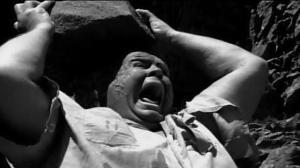
Into the Storm; Two Days, One Night; Sin City 2: A Dame to Kill For; Obvious Child
Into the Storm
Release date: 20 August 2014
Rating: 2.5/5
Almost twenty years after Twister, it’s quite surprising that it’s taken this long for a new tornado-themed disaster movie to make it to the big screen. The trailers for Into the Storm looked mildly promising: trashy, no doubt, and clichéd, naturally, but with the promise of some full blown destruction. Yet what the trailers don’t show is that the whole film is shot as a found footage movie – a pointless, incoherent decision. Whether the footage originates from professional tornado-chasing documentary makers or by two redneck adrenaline morons, it all looks the same. Even worse, there are frequently unmotivated camera angles – conversations are framed in the classic shot-reverse-shot technique, despite there being only one cameraman in the scene, overhead shots come from nowhere. Ostensibly the “found footage” style exists to add tension, but it never achieves this.
The characters themselves are all nondescript, and subplots like a blossoming teen romance are abandoned quickly. At one point a character instructs another to look after the footage because the film “might save lives one day” – how it could ever achieve this is unknown, because the science is non-existent. Like Twister, the final setpiece involves characters seeing the eye of the tornado – as though this is something new, when it’s already been achieved by both professional and amateur storm chasers in real life. Yet this is a film with the most generic, uninspiring of screenplays, so it’s little surprise that the motivation is mundane. That being said, some of the destruction is pretty nifty. It makes no sense, of course – whether a tiny little spout or a mile-wide behemoth (all of which instantaneously appear), all the tornadoes cause the same amount of damage: total carnage. Yet although it’s no doubt fun (for disaster movie fans, at least) to watch an airport be destroyed, or to see a fire-nado (a real thing), the best bits are all shown in the trailer. There’s simply not enough in the rest of the film to be worth watching. Perhaps the biggest problem is it takes itself too seriously. It appears to actually have honourable, educational intentions, despite being little better than a SyFy original movie. Truth is, if you want a good disaster movie, watch Twister and, if you want a bad one, why would you watch this when you could watch Sharknado?
Two Days, One Night
Release date: 22 August 2014
Rating: 3.5/5
The latest film by the Dardenne brothers, this is a gentle drama following Sandra (Marion Cotillard) over a weekend as she attempts to convince her colleagues to give up their bonuses so that she can keep her job. It’s a simple premise but an interesting one, and there are no real villains here – just normal people, trying to survive in a difficult world where, unfortunately, being selfish is often a necessity. Cotillard is entirely convincing as Sandra, who is hoping to return to work following extended sick leave due to a bout of depression. Her problems are cited as one of the reasons why she should not be brought back – her work may be compromised by her mental state. And if there is a problem with the Dardennes’ screenplay it is that she doesn’t seem to be ready. She cries over the smallest thing, is clearly stressed and fragile, and seems to barely be keeping herself together. Gaining equal support and rejection, as Monday looms closer she takes even more drastic measures, surely indicating that there is still a long way to go before she is truly stable, but it passes by with almost as little ceremony as any other moment in the film.
Despite the film’s simplicity, it’s not boring, largely due to the variety of characters Sandra meets. Two Days, One Night adopts an almost segmented structure, as Sandra goes to speak to each of her sixteen colleagues, hoping to sway them to her side. Although some of the conversations become a bit repetitive (particularly her having to explain why the vote is being recast), such is the strength of the performances that it feels authentic rather than tedious. Although Sandra is the film’s focus, Cotillard is fully supported by the rest of the cast, all of whom bring the characters to life, if only for a scene or two. There are no real surprises, no significant twists (apart from the aforementioned, which seems to have been included for a moment of drama, but I could have happily done without) – it’s a gentle, simple, well-crafted yet quite unremarkable movie, one that is pleasant but, ultimately, largely forgettable.
Sin City: A Dame to Kill For
Release date: 25 August 2014
Rating: 3/5
When Sin City was first released in 2005 it burst onto the screens, a grimy, dirty, adults-only noir the likes of which had never been seen. It’s a shame, therefore that, nine years later, the once eagerly awaited sequel proves to offer absolutely nothing new. Gone is the innovation of the first film; this one looks and sounds the same. Whether it could have done something vastly different is less the point than the fact that this is nine years later, and what was impressive in the mid-2000s is barely noticeable today. A Dame to Kill For, then, is in many ways the worst kind of sequel – outdated, unimaginative, uninspiring, routine. Yet for all that can be criticised about it, stylistically it still ticked the boxes for me. There are no complex characters or profound storylines here, of course, and anyone expecting them has been sorely misled. Instead, there is the usual bevy of hot, scantily clad, ass-kicking females, Eva Green in her typical vamp seductress role, heavy use of voice-over, and a bunch of actors punching well below their weight technically and well above their weight figuratively. Josh Brolin in particular is wasted in his role, while Joseph Gordon Levitt is adequate but largely irrelevant. I’ll always have a soft spot for Mickey Rourke, however, and despite the heavy prosthetics, he’s the only one who brings any life to his character – it seems he understands best of all that he need not take himself entirely seriously.
Sin City was a triumph of style over substance, and its sequel is no different. It may not be as original as the first (obviously), but visually it’s still quite beautiful. Heavily stylised, it’s hyper-noir, deliberately fantastical, explicitly acknowledging its graphic novel roots. In a time when the primary goal of most comic book movies appears to be realism, it’s quite a relief to see a film that rejects any guise of authenticity so entirely. That being said, the 3D is completely pointless – in a film that’s deliberately flat, all the 3D does is dull the bright white of the contrasting monochrome. As a final point, it should be said that, while A Dame to Kill For is violent (stylishly so), it barely seems to warrant its 18-rating – though perhaps this says more about the relaxation of the BBFC’s rating system than anything else. At a time when even Saw films can be a 15, Sin City‘s violence barely even matches that of a post-watershed television show – indeed, with shadows conveniently covering people’s lower halves, and blood shed in pretty arcs of white light, this is actually tamer than many series. Perhaps this is the final nail in the coffin for the movie, proving that in the nine years separating it from its predecessor, the world has changed, but Sin City has failed to keep up.
Obvious Child
Release date: 29 August 2014
Rating: 3/5
There’s usually a wild card at these press days – the film that no one’s heard of. Today, this was it, a small indie “comedy” about womanhood and the issues that matter. Whether you like it or not will most likely depend on a few factors: are you a woman, are you a feminist, do you enjoy jokes about bodily functions, how do you feel about abortion. Personally, I find it tedious that these films by women, for women still seem to be incapable of thinking outside the box, instead focusing, inevitably, on relationships and pregnancy. Is that really all that matters to the female human? If this film is anything to go by, as a gender we reclaim our femininity by discussing stains on knickers and saying the word “vagina” a lot (literally airing our dirty laundry in public), we drunk-phone ex-boyfriends like lunatics, and believe that it’s somehow acceptable to make the decision to have an abortion following a one-night stand yet – this is the important bit – not feel the need to inform the man about any of it. Obvious Child, the title taken from a Paul Simon song, offended me in the way that Sex and the City offended me, with its crudeness and self-obsessed whining.
Here, despite a strong performance from Jenny Slate as Donna, the almost-thirty woman-child forced to grow up after discovering she’s pregnant, it was difficult to really empathise with anyone on screen. Gaby Hoffmann, once a child actor seen saving LA from a volcano in Volcano, is one of the only recognisable faces, and her choice of roles in recent years seems to be deliberately based on feminist ideals, but her tirade about “a woman’s choice” is uninspiring. It’s particularly annoying that the men of the film are given such a raw deal. Donna’s dad pops up briefly, but serves no purpose. The ex boyfriend, ditto. The most rounded male character is gay (but stereotypically so), while the one-night-stand-turned-possible-love-interest (despite Jewish Donna worrying that he’s too “obviously Christian” to date) is easily one of the blandest characters ever – having not been told about the proposed abortion, he learns of Donna’s pregnancy when she uses the entire tale (including the forthcoming abortion) as part of her stand-up comedy routine. Yet even this isn’t enough to rouse Max, who is infuriatingly placid, supportive, and doesn’t even think to question Donna’s decision. Surely he should be at least the slightest bit annoyed at learning something so important at a comedy club? Shouldn’t he demand answers, or an explanation? Well, apparently not. In this movie, it appears to be only the females that are afforded any depth or complexity. Yet in the end, the writers seem to equate female empowerment with discussions about farting and defecation, as though that’s somehow something to aspire to. I remain unconvinced, and unamused.









